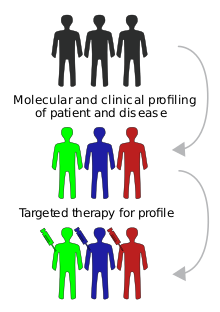
Back علاج موجه Arabic Target terapiya Azerbaijani Teràpia dirigida Catalan Gezielte Krebstherapie German Terapia dirigida Spanish Sihtmärkravi Estonian درمان هدفمند Persian Thérapeutique ciblée French Terapia dirixida Galician תרופה ביולוגית HE

Targeted therapy or molecularly targeted therapy is one of the major modalities of medical treatment (pharmacotherapy) for cancer,[1] others being hormonal therapy and cytotoxic chemotherapy. As a form of molecular medicine, targeted therapy blocks the growth of cancer cells by interfering with specific targeted molecules needed for carcinogenesis and tumor growth,[2] rather than by simply interfering with all rapidly dividing cells (e.g. with traditional chemotherapy). Because most agents for targeted therapy are biopharmaceuticals, the term biologic therapy is sometimes synonymous with targeted therapy when used in the context of cancer therapy (and thus distinguished from chemotherapy, that is, cytotoxic therapy). However, the modalities can be combined; antibody-drug conjugates combine biologic and cytotoxic mechanisms into one targeted therapy.
Another form of targeted therapy involves the use of nanoengineered enzymes to bind to a tumor cell such that the body's natural cell degradation process can digest the cell, effectively eliminating it from the body.
Targeted cancer therapies are expected to be more effective than older forms of treatments and less harmful to normal cells. Many targeted therapies are examples of immunotherapy (using immune mechanisms for therapeutic goals) developed by the field of cancer immunology. Thus, as immunomodulators, they are one type of biological response modifiers.
The most successful targeted therapies are chemical entities that target or preferentially target a protein or enzyme that carries a mutation or other genetic alteration that is specific to cancer cells and not found in normal host tissue. One of the most successful molecular targeted therapeutics is imatinib, marketed as Gleevec, which is a kinase inhibitor with exceptional affinity for the oncofusion protein BCR-Abl which is a strong driver of tumorigenesis in chronic myelogenous leukemia. Although employed in other indications, imatinib is most effective targeting BCR-Abl. Other examples of molecular targeted therapeutics targeting mutated oncogenes, include PLX27892 which targets mutant B-raf in melanoma.
There are targeted therapies for lung cancer, colorectal cancer, head and neck cancer, breast cancer, multiple myeloma, lymphoma, prostate cancer, melanoma and other cancers.[1][3][4]
Biomarkers are usually required to aid the selection of patients who will likely respond to a given targeted therapy.[5]
Co-targeted therapy involves the use of one or more therapeutics aimed at multiple targets, for example PI3K and MEK, in an attempt to generate a synergistic response[4] and prevent the development of drug resistance.[6][7]
The definitive experiments that showed that targeted therapy would reverse the malignant phenotype of tumor cells involved treating Her2/neu transformed cells with monoclonal antibodies in vitro and in vivo by Mark Greene's laboratory and reported from 1985.[8]
Some have challenged the use of the term, stating that drugs usually associated with the term are insufficiently selective.[9] The phrase occasionally appears in scare quotes: "targeted therapy".[10] Targeted therapies may also be described as "chemotherapy" or "non-cytotoxic chemotherapy", as "chemotherapy" strictly means only "treatment by chemicals". But in typical medical and general usage "chemotherapy" is now mostly used specifically for "traditional" cytotoxic chemotherapy.
- ^ a b Cordo' V, van der Zwet JC, Canté-Barrett K, Pieters R, Meijerink JP (January 2021). "T-cell Acute Lymphoblastic Leukemia: A Roadmap to Targeted Therapies". Blood Cancer Discovery. 2 (1): 19–31. doi:10.1158/2643-3230.BCD-20-0093. PMC 8447273. PMID 34661151.
- ^ "Definition of targeted therapy – NCI Dictionary of Cancer Terms".
- ^ "Targeted Cancer Therapies". National Cancer Institute. 15 September 2021.
- ^ a b Heavey S, O'Byrne KJ, Gately K (April 2014). "Strategies for co-targeting the PI3K/AKT/mTOR pathway in NSCLC". Cancer Treatment Reviews. 40 (3): 445–456. doi:10.1016/j.ctrv.2013.08.006. PMID 24055012.
- ^ Syn NL, Yong WP, Goh BC, Lee SC (August 2016). "Evolving landscape of tumor molecular profiling for personalized cancer therapy: a comprehensive review". Expert Opinion on Drug Metabolism & Toxicology. 12 (8): 911–922. doi:10.1080/17425255.2016.1196187. PMID 27249175. S2CID 205908189.
- ^ Heavey S, Dowling P, Moore G, Barr MP, Kelly N, Maher SG, et al. (January 2018). "Development and characterisation of a panel of phosphatidylinositide 3-kinase - mammalian target of rapamycin inhibitor resistant lung cancer cell lines". Scientific Reports. 8 (1): 1652. Bibcode:2018NatSR...8.1652H. doi:10.1038/s41598-018-19688-1. PMC 5786033. PMID 29374181.
- ^ Heavey S, Godwin P, Baird AM, Barr MP, Umezawa K, Cuffe S, et al. (October 2014). "Strategic targeting of the PI3K-NFκB axis in cisplatin-resistant NSCLC". Cancer Biology & Therapy. 15 (10): 1367–1377. doi:10.4161/cbt.29841. PMC 4130730. PMID 25025901.
- ^ Perantoni AO, Rice JM, Reed CD, Watatani M, Wenk ML (September 1987). "Activated neu oncogene sequences in primary tumors of the peripheral nervous system induced in rats by transplacental exposure to ethylnitrosourea". Proceedings of the National Academy of Sciences of the United States of America. 84 (17): 6317–6321. Bibcode:1987PNAS...84.6317P. doi:10.1073/pnas.84.17.6317. PMC 299062. PMID 3476947.
Drebin JA, Link VC, Weinberg RA, Greene MI (December 1986). "Inhibition of tumor growth by a monoclonal antibody reactive with an oncogene-encoded tumor antigen". Proceedings of the National Academy of Sciences of the United States of America. 83 (23): 9129–9133. Bibcode:1986PNAS...83.9129D. doi:10.1073/pnas.83.23.9129. PMC 387088. PMID 3466178.
Drebin JA, Link VC, Stern DF, Weinberg RA, Greene MI (July 1985). "Down-modulation of an oncogene protein product and reversion of the transformed phenotype by monoclonal antibodies". Cell. 41 (3): 697–706. doi:10.1016/S0092-8674(85)80050-7. PMID 2860972. S2CID 26000048. - ^ Zhukov NV, Tjulandin SA (May 2008). "Targeted therapy in the treatment of solid tumors: practice contradicts theory". Biochemistry. Biokhimiia. 73 (5): 605–618. doi:10.1134/S000629790805012X. PMID 18605984. S2CID 1223977.
- ^ Markman M (2008). "The promise and perils of 'targeted therapy' of advanced ovarian cancer". Oncology. 74 (1–2): 1–6. doi:10.1159/000138349. PMID 18536523. S2CID 44821306.
© MMXXIII Rich X Search. We shall prevail. All rights reserved. Rich X Search